What is turbidity?
Turbidity is a measure of water clarity or murkiness. It is an optical property that expresses the degree to which light is scattered and absorbed by molecules and particles. Turbidity results from coloured dissolved organic matter (CDOM; e.g humic substances) and suspended particulate matter in the water column. Suspended particulate matter may include clay and silt (e.g suspended sediment), and detritus and organisms (algae and zooplankton). Degree of turbidity and changes in turbidity levels in coastal and estuarine waters are an indicator for State of the Environment reporting1.
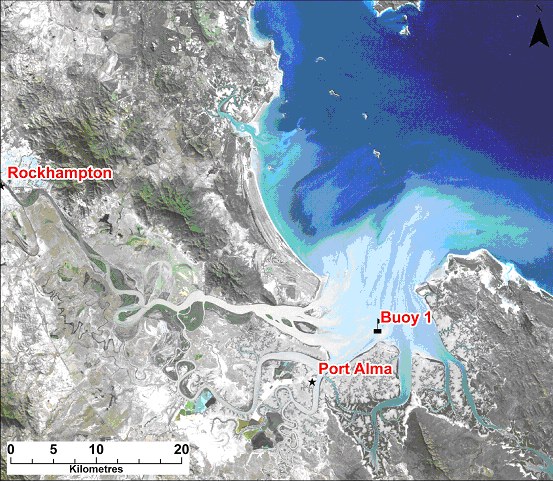
Photo 1. A landsat TM image of the Fitzroy Estuary and Keppel Bay (Queensland, Australia) from May 2003. The whitish colouration of the water near the estuary mouth is due to suspended sediment (see photo 2).
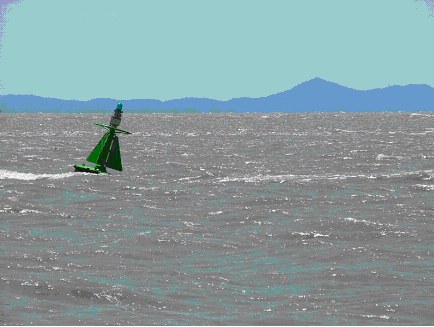
Photo 2. Photograph a buoy 1 in Keppel Bay (Photo 1) when suspended sediment concentrations were in the order of 300 mg L-1 (photograph by Peter Verwey).
Natural controls on turbidity levels
On hourly time-scales, the primary mechanisms which govern turbidity variability in estuaries are the resuspension, deposition and advection of sediment.
Tide-dominated coastal waterways (e.g. deltas, estuaries and tidal creeks) are naturally turbid because strong tidal currents resuspend fine sediment (Figure 1, photo 1 & 2). Tidal currents have the capacity to mobilise fine sediments (including clays, silts and fine sands) over most of the northern and north-eastern sections of Australia’s continental shelf (Figure 2)2. Total suspended solids may naturally attain several grams per litre in the meso- and macro-tidal coastal waterways (e.g. mean tidal range > 2m) that occur in this region3, and turbidity levels can vary considerably due to the spring-neap cycle of high and low tidal ranges and the daily cycle of high and low tides (Figure 3).
A turbidity maximum occurs in some coastal waterways. It is caused by the trapping and flocculation of sediment at the wedge (e.g. salinity discontinuity) between freshwater and seawater (see Figure 4). The turbidity maximum often occurs in the vicinity of the 2 ppt isohaline4. It is mainly controlled by tidal processes in macrotidal or hypertidal estuaries, although it may migrate in response to changes in freshwater inflow (see Figure 4). In microtidal estuaries it usually occurs during sporadic river freshets5.
There is a tendency for long, macrotidal estuaries to have higher suspended sediment concentrations (in the high turbidity zones) than shorter systems with comparable tidal ranges5. Long microtidal estuaries may also have naturally high turbidity levels5
As a general rule, short microtidal estuaries are expected to have low suspended sediment concentrations [17]. Persistent and relatively high turbidity levels in such systems may be an indicator of human impact (Figure 1)1. Short microtidal estuaries with relatively shallow central basins may be an exception to this general rule due to wave-induced resuspension (see photo 3)5.

Figure 1. Turbidity is naturally low in wave-dominated coastal systems and naturally high in tide-dominated coastal systems (from https://data.gov.au/dataset/australian-estuaries-and-coastal-waterways-a-geoscience-perspective-for-improved-and-integrated).
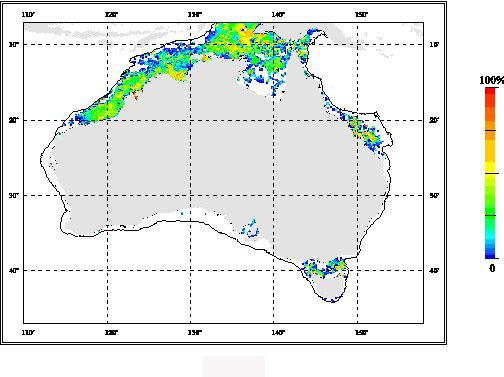
Figure 2. Tidal currents that exceed the threshold speed for mean grain size on the Australian continental shelf2. Note that tidal currents have the capacity to mobilise fine sediments (clays, silts and fine sands) over most of the northern and north-eastern sections of the shelf2.
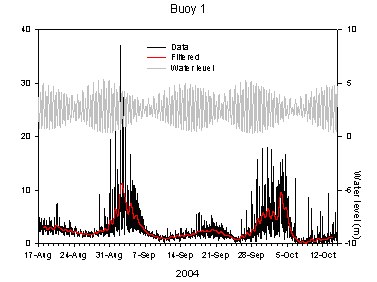
Figure 3.Time series of measured turbidity levels from a meter deployment at Buoy 1 in Keppel Bay (near the mouth of the Fitzroy River (see photo 1 & 2; 6 ). Also shown are this time series low-pass filtered and the time series of predicted water levels at Port Alma6. Turbidity during neap tides is many times lower than the turbidity maximum even though neap tidal currents have amplitudes that are about half of those occurring during spring tides. This is due to resuspension.
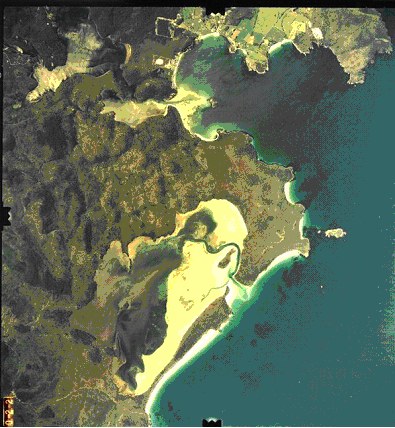
Photo 3. Image of Southport Lagoon – a listed near-pristine estuary – with a large turbidity plume that was likely caused by a wind driven event. (The aerial photo was captured by the Information and Land Services (ILS), DPIWE, Tasmanian Government. It is flight and frame number 1124-137 taken on 15/12/1988 and is at 1:42,000 scale.).
Causes of unnaturally high turbidity levels
- Turbidity in coastal waterways can result from the input/influence of fine sediments caused by gully and streambank erosion and sheetwash (i.e. catchment inputs in Figure 4)7. Catchments with extensive erosion problems tend to contain large areas which have been cleared of native vegetation, support intensive agriculture and be situated in seasonally dry climatic regions7.
- Algal blooms are often indicative of excessive nutrient loads, and can be an important cause of turbidity in eutrophic systems.
- Other causes of turbidity in coastal waters include: dissolved organic matter from sewage treatment plants and wash from construction sites (see urban inputs in Figure 4); shoreline erosion; dredging; and humic substances. In a study on New South Wales estuaries, turbidity proved informative as an indicator, and was linked to nutrient loads and to the percentage of the catchment under urbanisation8.
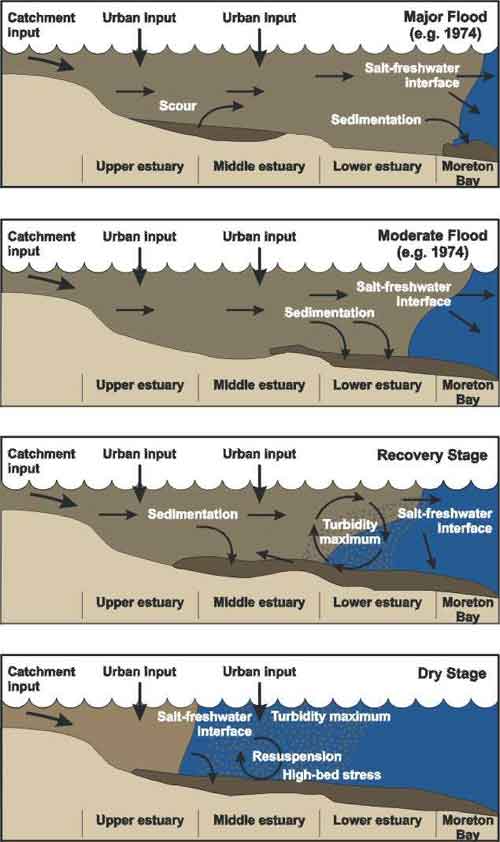
Figure 4. Conceptual model of some processes maintaining turbidity in the Brisbane River Estuary flowing into Moreton Bay. Note that the turbidity maximum migrates in response to flooding events (From Dennison and Abal (1999)9; Reproduced with permission of Healthy Waterways Library).
Significance of turbidity
Water clarity is a major determinant of the condition and productivity of an aquatic system, and of the tractability of water for human consumption, recreation and manufacturing. Increased turbidity can change an ecosystem significantly. Suspended sediment particles control the transport, reactivity and biological impacts of substances in the marine environment, and are a crucial link in interactions between the seabed, water column and the food chain10.
The most obvious effect of increased turbidity is a reduction in light available for photosynthesis. Phytoplankton and free-floating macroalgae are better competitors for light than benthic plants (including seagrasses)11, and will tend to out-compete them as light becomes limiting during progressive eutrophication. Competition between the benthos and pelagic communities for light and nutrients also gives rise to hysteresis effects. Notwithstanding these effects, turbidity also controls the phytoplankton biomass that can potentially develop (see Figure 2 on chlorophyll a fact sheet)1213, and therefore the extent to which dissolved nutrients can build up in the water column. With high concentrations of nutrients in the water column under turbid conditions, denitrification may become coupled to water column nitrate rather than to nitrification14.
Suspended sediment can smother benthic organisms and habitats when it settles, and can cause mechanical and abrasive impairment to the gills of fish and crustaceans15. Suspended sediment also transports contaminants (particulate nutrients, metals and other potential toxicants)15, promotes the growth of pathogens and waterborne diseases, makes pathogens and waterborne diseases, makes marine pests difficult to detect16 and can lead to dissolved oxygen depletion in the water column if it is caused by particulate organic matter. Overall, unnaturally high turbidity levels can lead to a reduction in the production and diversity of species.
Considerations for the interpretation of turbidity data
At the scale of weeks and days, the spring-neap cycle of high and low tidal ranges has a very large influence on suspended sediment concentrations, as does the daily cycle of high and low tides (Figure 3; 6 ). Suspended matter is also spatially heterogeneous, and synoptic information is hard to obtain from routine in situ monitoring. The spatial variability and fluctuations associated with natural turbidity cycles should be considered when setting water quality targets pertaining to water column light availability, particularly where tide-dominated waterways (tidal creeks, estuaries and deltas) are concerned.
Remote sensing with sensor systems such as MODIS can overcome the temporal and spatial uncertainties inherent in manual sample collection of turbidity samples17. Moreover, the processing of raw satellite images can be automated because the input data is highly standardised. This improves the cost-effectiveness of remote sensing in the long-term, and provides large, standardised, data sets17. Traditional turbidity measures comprise a wide variety of techniques, and this can lead to data compatibility problems when different data sources are compared. The traditional turbidity measurements and remote sensing are discussed in more detail in the following section.
Measuring Turbidity
Suspended matter, algal pigments and CDOM absorb and scatter light (forward and backwards) as a function of their concentrations and specific absorption and scattering characteristics, and thus affect the underwater light field. The measures turbidity, Secchi disk transparency and vertical light attenuation (described below) are all a function of these optically active components. Total suspended matter (TSM) is another measure of water column and benthos light availability, but does not include the coloured dissolved substances.
Measuring Turbidity
Turbidity, per se, is a poorly defined term because it is measured in different ways. Instrumentation for assessing turbidity either measures the loss of light by absorption (i.e. in transmissomtery), or the (back) scattering of light by particles (i.e. the reflected light approach or nephelometry).
Transmissomtery
In transmissometry, a calibrated beam of light is projected through the water to a light detector over a set distance (usually less than 300mm). The loss in the intensity or absorption of light is then measured and correlated to the turbidity. Transmissometry is sensitive to very low turbidity levels and is more commonly employed in the open ocean or estuaries with very low levels of suspended sediment.
Nephelometry
Nephelometry compares the intensity of light scattered by a sample with the intensity of light scattered by a standard reference suspension under the same conditions. Light is emitted with a wavelength usually between 830nm and 890nm, and the amount of light returning to the detector via scattering from the suspended particles is measured. Measurements are made at a set range of degrees, usually within 70 to 170 degrees of the emission direction. The distance between the emitter and detector is usually less than 15mm. This method has a high level of precision at low and high turbidity levels, and natural light has usually no effect on the readings. The units of measurement in this case are Nephelometric Turbidity Units (NTUs). Turbidimeters equipped with nephelometers are well suited to field measurement, and many have the facility to continuously monitor turbidity in a time-series (see Figure 3). The commonly recommended method for calibrating nephelometric turbidity meters is by using suspensions of micro spheres of styrene-divinyl benzene co-polymer such as AMOCO-AEPA standards. These solutions are stable and the spheres maintain a homogenous suspension. Therefore the calibrations are precise.
Some Precautions with turbidity measurements
Scientists often advise against the use of turbidity due to the lack of standardisation in the method (see above), and because different models of turbidity meters may not give exactly the same reading due to optical differences17. Notwithstanding these potential problems, it is a useful tool for rapidly quantifying suspended matter concentrations in an estuary, as long as a stable calibration is maintained and the readings are quantified against TSM (Figure 5). Some additional points to consider when measuring turbidity are as follows:
- Turbidity meters may need more than a two-point calibration.
- Momentary spikes in the turbidity data may indicate the passing of large particles such as plant detritus or small water animals.
- When profiling, do not let the turbidity detector touch the estuary bottom as the turbulence around the instrument will stir up additional sediment.
- The slope of the correlation between NTU’S and milligrams per litre of suspended matter (see example in Figure 5) will vary slightly from estuary to estuary, and possibly within a give estuary, because the relationship is sensitive to the shape and composition of the suspended matter17.
- Instrument optics need to be kept very clean, as they may easily become coated in organic films (tannins or algal residue) or animals, or they may become scratched. These disturbances will greatly affect the path of light and thus affect the turbidity readings. To over come this some manufacturers have fitted wipers to the optics to regularly clean the optical surfaces. Be aware though, that sand particles can get trapped in the wiper and scratch the optics.
![Relationship between measured TSM and measured turbidity across Keppel Bay and in Casuarina Creek (photo 1) in August 2004 [13]. Relationship between measured TSM and measured turbidity across Keppel Bay and in Casuarina Creek (photo 1) in August 2004 [13].](/wp-content/uploads/2016/09/turbidity_fig5.jpg)
Figure 5. Relationship between measured TSM and measured turbidity across Keppel Bay and in Casuarina Creek (photo 1) in August 20046.
Vertical light attenuation and Secchi Depth measurements
Vertical light attenuation (Kd) and Secchi Depth measurements are the appropriate measures for coastal and marine waters, when the goal is to quantify the depth to which light penetrates in the water column12. This distinction can be important in stratified water columns because suspended sediment concentrations can be low in surface waters, but high at the intersection between freshwater and seawater (Figure 6). Using light sensors, Kd measures the attenuation of light with depth due to the combined effects of backscattering and absorption. It exactly quantifies the amount of light that is available for photosynthesis, and the euphotic depth (i.e. the depth at which photosynthetically-active radiation (PAR) is reduced to about 1%).
Secchi depth is simply assessed by lowering a black and white circular plate (Secchi disk) into the water column (Figure 6). It is a two-way vertical attenuation reading in the respect that light travels to the disk and back up again to the observer. The depth at which the disk is no longer visible is called the Secchi depth. A simple rule of thumb is that light can penetrate to ~2-3 times the Secchi Depth. This method is inexpensive, and is not subject to instrument failure. However, Secchi readings are susceptible to human error and bias.
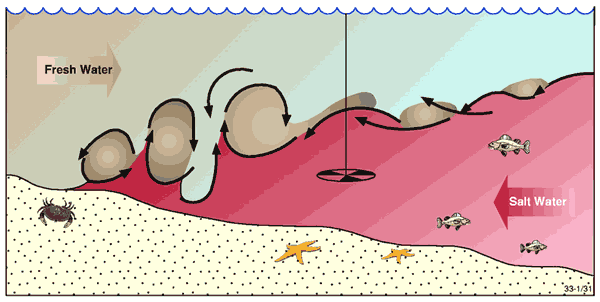
Figure 6. The black and white plate is called a secchi disk. (Illustration modified after http://www.epa.gov/owow/estuaries/). A turbidity maximum can occur at the inter-section of freshwater and seawater, and is caused by the flocculation of fine particles.
Total suspended matter measurements
Total suspended matter (TSM) is a gravimetric measure of the mass of suspended material in a given volume of water sample that does not pass though a filter (usually with a pore size of 0.45 µm; photo 4). It is composed of mineral matter (sediment or soil), phytoplankton, plant and animal debris, and may be variously referred to as suspended particulate matter (or SPM) or total suspended solids (TSS).
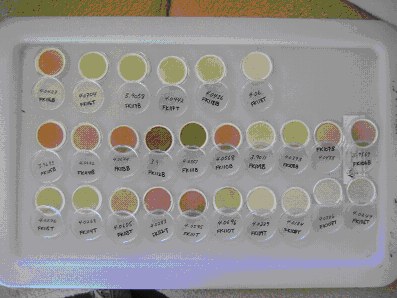
Photo 4. Filter papers with suspended matter collected from Keppel Bay and near-shore environments (photo 1) during a survey in August 2004. Note that the wide range of suspended sediment concentrations is evident in the colour of the filter papers.
Remote Sensing
Satellite remote sensing is the collection of information about the earth’s surface using sensors mounted to satellites. Data from satellite images is spatially and temporally dense. Each pixel in an image represents an area of the earth’s surface that ranges in size from a few metres to greater than a kilometre, and these pixels can be measured as frequently as twice a day.
TSM concentrations can be determined through remote sensing (Figure 7), by establishing an empirical relationship between scattering in the green, red or near infrared wavelengths and TSM concentrations17. As mentioned previously, turbidity, Secchi disk transparency and Kd are a function of the combined effects of TSM, chlorophyll and CDOM. Site-specific algorithms can also be developed to resolve these properties17.
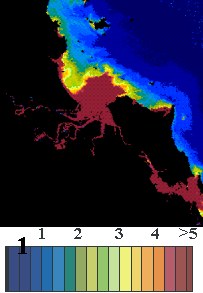
Figure 7. TSS concentrations in Keppel Bay inferred from Meris satellite overpass on 7 September, 2003. Concentrations are in g m-3. TSS concentrations over the southern part of the bay around the estuary mouth at this time were mostly in excess of 5 gm317.
Existing information and data
Turbidity is a routine and simple measurement and large amounts of data exist for estuaries and coastal waters from around Australia. The data is held by the collecting agencies (State, local Government, community groups and environmental consultants). However, the wide variety of sources and collection techniques could create problems of data compatibility. the Department of Environment, Water, Heritage and the Arts provides OnLine water quality targets for turbidity (in NTUs) on a bioregional basis, to protect each of ecosystem protection, recreation and safe aquaculture/human consumption values. the Department of Environment, Water, Heritage and the Arts also provides guidelines for State of the Environment reporting.
NLWRA 2008: Estuarine, coastal and marine habitat condition, indicator guideline
Turbidity/water clarity
More information
Research needs and questions
Given the strong influence of tide energy on turbidity levels, separate sets of default water quality targets for turbidity should be derived for tide- and wave-dominated systems.
Contributors
Ian Atkinson, Geoscience Australia
Vitorrio Brando, CSIRO Land & Water
Peter Harris, Geoscience Australia
Andrew Heap, Geoscience Australia
Richard Mount, University of Tasmania
Lynda Radke, Geoscience Australia
David Ryan, Geoscience Australia
Peter Scanes, Department of Environment and conservation, NSW
- Ward, T., Butler, E. and Hill, B. 1998. Environmental Indicators for National State of the Environment Reporting, Estuaries and the Sea, Commonwealth of Australia, pp. 81. ↩ ↩
- Porter-Smith, R., Harris, P.T., Andersen, O.B., Coleman, R., Greenslade, D. and Jenkins, C.J. 2004. Classification of the Australian continental shelf based on predicted sediment threshold exceedance from tidal currents and swell waves. Marine Geology 211, 1-20. ↩ ↩ ↩
- Heap, A., Bryce, S., Ryan, D., Radke, L., Smith, C., Smith, R., Harris, P. and D. Heggie. 2001. https://data.gov.au/dataset/australian-estuaries-and-coastal-waterways-a-geoscience-perspective-for-improved-and-integrated. AGSO Record 2001/07, pp. 118. ↩
- Jassby, A.D., Kimmerer, W.J., Monismith, S.G., Armor, C., Powell, T.M., Schubel, J.R., and Vendlinski, T.J. 1995. Isohaline position as a habitat indicator for estuarine populations. Ecological Applications 5(1), 272-289. ↩
- Uncles, R.J., Stephens, J.A., and Smith, R.E. 2002. The dependence of estuarine turbidity on tidal intrusion length, tidal range and residence time. Continental Shelf Research 22, 1835-1856. ↩ ↩ ↩ ↩
- I. Webster, I. Atkinson, H. Bostock, B. Brooke, G. Douglas, P. Ford, G. Hancock, M. Herzfeld, R. Leeming, C. Lemckert, N. Margvelashvili, B. Noble, K. Oubelkheir, L. Radke, A. Revill, B. Robson, D. Ryan, C. Schacht, C. Smith, J. Smith, V. Vicente-Beckett, I. Webster, K. Wild-Allen. 2006. The Fitzroy Contaminants Project – A Study of the Nutrient and Fine-Sediment Dynamics of the Fitzroy Estuary and Keppel Bay. Cooperative Research Centre for Coastal Zone, Estuary & Waterway Management Technical Report #42. ↩ ↩ ↩ ↩
- National Land and Water Resources Audit 2002. Australian Catchment, river and estuary assessment 2002, volume 1, Commonwealth of Australia 2002. ↩ ↩
- Peter Scanes , Geoff Coade, Maria Doherty, Ross Hill. Evaluation of the Utility of Water Quality Based Indicators of Estuarine Lagoon Condition in NSW, Australia. Submitted to Estuarine, Coastal and Shelf Science. ↩
- Dennsion, W.C. and Abal, E.G. 1999. Moreton Bay Study: A Scientific Basis for the Healthy Waterways Campaign, South East Queensland Water Quality Management Strategy, pp. 245. ↩
- Turner, A., and G.E. Millward. 2002. Suspended particles: Their role in estuarine biogeochemical cycles. Estuarine, Coastal and Shelf Science 55, 857-883. ↩
- Duarte, C.M. 1995. Submerged aquatic vegetation in relation to different nutrient regimes. Ophelia 41, 87-112. ↩
- Monbet, Y. 1992. Control of phytoplankton biomass in estuaries: A comparative analysis of microtidal and macrotidal estuaries. Estuaries 15(4), 563-571. ↩ ↩
- Cloern, J.E. 1987. Turbidity as a control on phytoplankton biomass and productivity in estuaries. Continental Shelf Research 7(11/12), 1367-1381. ↩
- Eyre, B.D. and Ferguson, A.J.P. 2002. Comparison of carbon production and decomposition, benthic nutrient fluxes and denitrification in seagrass, phytoplankton, benthic microalgae- and macroalgae-dominated warm-temperate Australian lagoons. Marine Ecology Progress Series 229, 43-59. ↩
- ANZECC/ARMCANZ (October 2000) Australian Guidelines for Water Quality Monitoring and Reporting. http://www.ea.gov.au/water/quality/nwqms. ↩ ↩
- Neil, K.M. 2002. The detection, response and challenges of a pest detection. Proceedings of the annual conference of the Australian Marine Sciences Association, 10-12 July 2002, Fremantle WA. ↩
- Brando, V., Dekker, A., Marks, A., Qin, Y and Oubelkheir, K. 2006. Chlorophyll and suspended sediment assessment in a macrotidal tropical estuary adjacent to the Great Barrier Reef: spatial and temporal assessment using remote sensing. Cooperative Research Centre for Coastal Zone, Estuary & Waterway Management Technical Report 74. ↩ ↩ ↩ ↩ ↩ ↩ ↩


